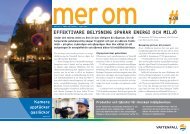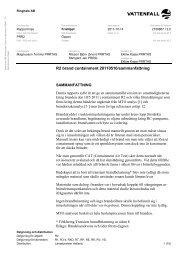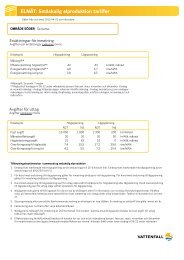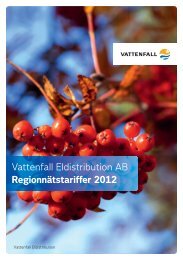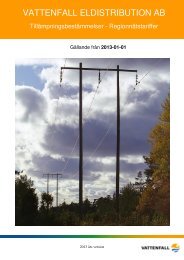This environmental impact assessment for Kriegers flak ... - Vattenfall
This environmental impact assessment for Kriegers flak ... - Vattenfall
This environmental impact assessment for Kriegers flak ... - Vattenfall
Create successful ePaper yourself
Turn your PDF publications into a flip-book with our unique Google optimized e-Paper software.
88 PRESENTATION OF THE AREA<br />
to acquire knowledge of the nocturnal migration and<br />
height distribution during day as well as night.<br />
Since radar lack coverage in the lowest interval,<br />
visual studies were needed to register the migrations<br />
below 10 m height. Visual and radar studies were<br />
there<strong>for</strong>e carried out in parallel in order to detect at<br />
which height each individual species is migrating at.<br />
During the two test years, a total of 139 species of<br />
birds have been observed migrating through the area,<br />
see tables below. A complete list of the species is found<br />
in Appendix 8.2.<br />
There are very few studies of birds carried out at<br />
sea. Earlier studies have been conducted from the coast<br />
to a distance of about 5 km. The study carried by the<br />
company could there<strong>for</strong>e be regarded as pioneer work.<br />
Those documented studies of migrating birds across<br />
the southern Baltic and its vicinity, have on behalf of<br />
the company been collated by IfAÖ in a literary study<br />
(see below).<br />
It is difÞ cult to summarise all the results from the<br />
above mentioned surveys. Only matters relevant <strong>for</strong> the<br />
planned project are dealt with here.<br />
Year 1<br />
April 2002–March 2003<br />
Days of observation 65 58<br />
Number of species 117 110<br />
Number of individuals, total 19.002 43.618<br />
Individuals of defi nite species 17.090 42.084<br />
Number of water fowl 14.966 40.005<br />
Number of land birds 2.124 2.079<br />
Individuals with no defi nite species 1.912 1.534<br />
Most frequent species Eider (6.501)<br />
Barnacle goose (4.675)<br />
Wigeon (1.329)<br />
Brent goose (868)<br />
Common scooter (796)<br />
Crane (474)<br />
Siskin (270)<br />
Chaffi nch (249)<br />
Meadow pipit (239)<br />
Skylark (145)<br />
Species with highest continuity Cormorant (35)<br />
Common scooter (31)<br />
Eider (25)<br />
Pied wagtail (23)<br />
Barn swallow (22)<br />
Black-throated diver (20)<br />
Skylark (20)<br />
Chaffi nch (20)<br />
Meadow pipit (19)<br />
Wigeon/Dwarf gul (17)<br />
Summary survey of migrating birds 2002 – 2004<br />
Year 2<br />
April 2003–March 2004<br />
Eider (30.662)<br />
Barnacle goose (4.773)<br />
Brent goose (1.418)<br />
Common scooter (1.371)<br />
Crane (905)<br />
Wigeon (350)<br />
Greylag goose (221)<br />
Cormorant (210)<br />
Meadow pipit (185)<br />
Barn swallow (133)<br />
Eider (41)<br />
Common scooter (33)<br />
Cormorant (31)<br />
Barn swallow (26)<br />
Graylag goose (22)<br />
Common swift (21)<br />
Lesser black-backed gull (17)<br />
Meadow pipit (17)<br />
Pied wagtail /Skylark/Black-headed<br />
gull / Dwarf gull (16)





